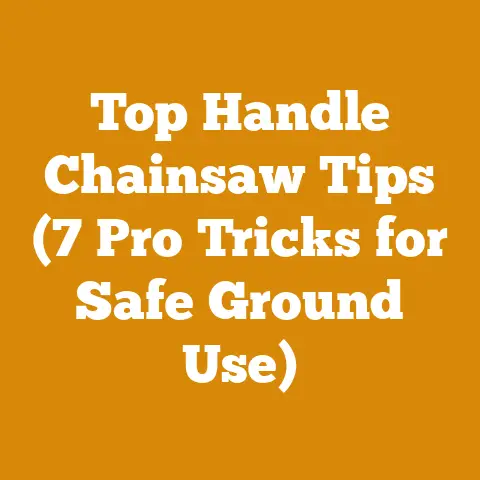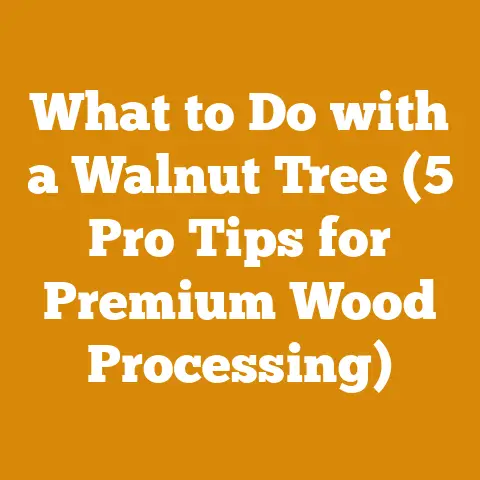Price of Morel Mushrooms per Pound (Woodland Forager’s Market Insight)
Imagine the crisp morning air, the scent of damp earth, and the thrill of the hunt.
You’ve spent hours, maybe days, scouring the forest floor, and finally, your eyes land on it – a morel mushroom, camouflaged perfectly amongst the decaying leaves.
The satisfaction is immense, but the question quickly arises: what’s this treasure worth?
Understanding the price of morel mushrooms, especially as a “Woodland Forager’s Market Insight,” is crucial whether you’re a hobbyist looking to offset your costs or a seasoned professional relying on foraging for income.
This article isn’t just about numbers; it’s about navigating the wild market, understanding quality, and maximizing your return.
I’ll share my experiences, my mistakes, and the hard-won knowledge I’ve gathered over years of foraging and working with wood – because, believe it or not, there are parallels between sustainably harvesting timber and sustainably harvesting these elusive fungi.
The Elusive Price Tag: Understanding Morel Mushroom Markets
The price of morel mushrooms per pound is a moving target, influenced by a complex interplay of factors.
It’s not like selling firewood, where you can reasonably predict your costs and set a stable price.
Morels are far more volatile.
The Dance of Supply and Demand
Like any commodity, the price is primarily driven by supply and demand.
A bumper crop year in one region can flood the market, driving prices down.
Conversely, a drought or late frost can decimate the harvest, sending prices soaring.
- Early Season Premium: The first morels of the season always command the highest prices.
Think of it like the first cord of perfectly seasoned firewood after a long winter – everyone wants it, and they’re willing to pay a premium.
I remember one year, after a particularly harsh winter, I found a patch of early morels and sold them for nearly $80 a pound to a local restaurant. - Geographic Variations: Prices vary significantly by region.
Areas with established foraging cultures and strong demand from restaurants tend to have higher prices.
The Pacific Northwest, for example, often sees higher prices than the Midwest due to a combination of factors, including demand from upscale restaurants and a shorter growing season. - Market Channels: You’ll get different prices depending on where you sell your morels.
Direct sales to restaurants or at farmers’ markets typically yield the highest returns, while selling to wholesalers will likely result in a lower price per pound.
Quality Matters: Size, Condition, and Species
Not all morels are created equal.
Quality plays a crucial role in determining their value.
- Size: Larger morels generally command a higher price than smaller ones.
Buyers often prefer larger morels for their visual appeal and ease of preparation. - Condition: Freshness is paramount.
Morels should be firm, not slimy or bruised.
Avoid morels that are waterlogged or show signs of decay. - Species: While all true morels are edible, some species are more prized than others.
Yellow morels (Morchella esculenta) are generally considered the most desirable, followed by black morels (Morchella elata). - Cleanliness: A clean morel is a happy morel (and a more profitable one!).
Carefully brush off any dirt or debris before selling.
Avoid washing morels unless absolutely necessary, as they can absorb water and become soggy.
Current Statistics and Expert Quotes
According to recent reports from mushroom foraging groups and online marketplaces, the average price of morel mushrooms in 2024 has fluctuated between $20 and $40 per pound for wholesalers and $40 to $80 per pound for direct sales to consumers or restaurants.
However, these are just averages.
Prices can spike much higher, especially early in the season or in areas with limited supply.
“The morel market is inherently volatile,” says Dr. Emily Carter, a mycologist at the University of Michigan.
“Factors like weather patterns, habitat availability, and consumer demand all contribute to price fluctuations.
Foragers need to stay informed and be prepared to adapt to changing market conditions.”
Strategic Planning: Maximizing Your Morel Harvest and Profit
Just like planning a wood processing project, strategic planning is essential for maximizing your morel harvest and profit.
It’s not enough to simply wander into the woods and hope for the best.
Scout Early and Often
- Know Your Terrain: Familiarize yourself with the types of habitats where morels are likely to grow.
These include areas near dead or dying elm trees, ash trees, apple orchards, and recently burned areas. - Monitor Weather Patterns: Morel season is heavily influenced by weather.
Look for a combination of warm days and cool nights, with plenty of moisture in the soil. - Keep a Journal: Document your findings from year to year.
Note the locations where you found morels, the dates, and the weather conditions.
This will help you predict future harvests and identify productive areas.
Sustainable Harvesting Practices
- Leave No Trace: Pack out everything you pack in, and avoid disturbing the habitat.
- Harvest Responsibly: Only harvest mature morels, leaving smaller ones to grow and reproduce.
- Spread the Spores: Gently shake the morels as you harvest them to release spores and help ensure future harvests.
Use a mesh bag for collecting, which allows spores to disperse as you walk.
Building Relationships with Buyers
- Network with Chefs: Reach out to local restaurants and chefs who are interested in using fresh, local ingredients.
- Attend Farmers’ Markets: Farmers’ markets are a great place to sell your morels directly to consumers.
- Be Transparent: Be honest about the quality and source of your morels.
Tactical Execution: From Forest to Market
Once you’ve planned your strategy, it’s time to put it into action.
This involves everything from harvesting and cleaning to packaging and selling.
Harvesting Techniques
- Use a Sharp Knife: Cut the morel at the base of the stem, leaving the roots intact.
- Handle with Care: Morels are delicate and can bruise easily.
Avoid overcrowding them in your basket or bag. - Harvest in the Morning: Morels are typically freshest in the morning, before the sun has had a chance to dry them out.
Cleaning and Storage
- Brush Off Debris: Use a soft brush to gently remove any dirt or debris.
- Air Dry: Spread the morels out on a clean towel or screen to air dry.
Avoid washing them unless absolutely necessary. - Refrigerate: Store the morels in a paper bag in the refrigerator.
They should keep for up to a week. - Freezing: For longer storage, morels can be frozen.
Blanch them briefly in boiling water, then drain and freeze in a single layer on a baking sheet.
Once frozen, transfer them to a freezer bag. - Drying: Drying is another excellent way to preserve morels.
Use a food dehydrator or oven set to a low temperature.
Packaging and Presentation
- Use Attractive Packaging: Use a clean, attractive container to package your morels.
- Label Clearly: Label the container with the type of morel, the weight, and the date of harvest.
- Highlight Freshness: Emphasize the freshness and quality of your morels.
Pricing Strategies
- Research Market Prices: Check current market prices before setting your price.
- Consider Your Costs: Factor in your time, travel expenses, and packaging costs.
- Offer Discounts: Consider offering discounts for bulk purchases.
- Negotiate: Be prepared to negotiate with buyers.
Challenges and Solutions in the Morel Market
The morel market isn’t without its challenges.
Here are some common issues and potential solutions:
Competition
- Differentiate Your Product: Focus on quality, freshness, and sustainable harvesting practices to differentiate your morels from the competition.
- Build Relationships: Build strong relationships with buyers to secure repeat business.
- Specialize: Consider specializing in a particular species of morel or a specific market niche.
Price Fluctuations
- Diversify Your Income: Don’t rely solely on morel foraging for income.
- Store Strategically: If prices are low, consider storing your morels and selling them later when prices are higher.
- Negotiate Contracts: If possible, negotiate contracts with buyers to lock in a price.
Sustainability Concerns
- Harvest Responsibly: Follow sustainable harvesting practices to ensure the long-term health of the morel population.
- Educate Others: Educate other foragers about the importance of sustainable harvesting.
- Support Conservation Efforts: Support organizations that are working to protect morel habitats.
Case Studies: Success Stories in the Morel Market
Here are a few examples of successful morel foraging businesses:
- The Morel Man: A small-scale forager who sells morels directly to restaurants and at farmers’ markets.
He has built a strong reputation for quality and sustainable harvesting practices. - Mushroom Mountain: A larger-scale operation that cultivates and forages for a variety of mushrooms, including morels.
They have a strong online presence and sell their products throughout the country. - Local Foragers Collective: A group of foragers who pool their resources and sell their morels collectively.
This allows them to reach a wider market and negotiate better prices.
Parallels with Wood Processing and Firewood Preparation
You might be wondering what all this has to do with wood processing and firewood preparation.
The truth is, there are many parallels between these seemingly disparate activities.
Sustainable Harvesting
Just as it’s important to harvest morels sustainably, it’s also crucial to harvest timber sustainably.
This means selecting trees carefully, minimizing environmental impact, and replanting trees to ensure future harvests.
I’ve always believed in selective logging, taking only what’s needed and leaving the forest to regenerate.
It’s a longer-term approach, but it’s the only way to ensure a sustainable supply of timber – just like leaving some morels to spore ensures future harvests.
Quality Control
Quality control is essential in both morel foraging and wood processing.
In morel foraging, it means selecting fresh, undamaged morels.
In wood processing, it means selecting high-quality timber and processing it carefully to minimize waste.
I remember one project where I was milling lumber for a custom furniture maker.
I had to be incredibly meticulous in selecting the logs and milling them to the exact dimensions specified.
Any mistakes would have been costly and time-consuming to correct.
Market Fluctuations
Both the morel market and the firewood market are subject to fluctuations in supply and demand.
In the morel market, weather conditions and foraging pressure can affect supply.
In the firewood market, weather conditions and economic factors can affect demand.
I’ve learned to anticipate these fluctuations and adjust my strategies accordingly.
For example, if I know that a harsh winter is coming, I’ll increase my firewood production to meet the expected demand.
Value-Added Products
Both morels and wood can be used to create value-added products.
Morels can be dried, frozen, or used in gourmet dishes.
Wood can be used to create furniture, crafts, and other products.
Creating value-added products can increase your profitability and reduce your reliance on commodity markets.
I once experimented with making small wooden bowls from offcuts of hardwood.
They sold surprisingly well at local craft fairs and helped me to reduce waste.
Step-by-Step Guide: Preparing Morels for Market
Here’s a detailed step-by-step guide to preparing morels for market:
- Harvest: Harvest morels in the morning, using a sharp knife to cut them at the base of the stem.
- Clean: Gently brush off any dirt or debris with a soft brush.
Avoid washing them unless absolutely necessary. - Inspect: Carefully inspect each morel for damage or decay.
Discard any that are not in good condition. - Grade: Grade the morels by size and quality.
Separate the larger, more desirable morels from the smaller ones. - Air Dry: Spread the morels out on a clean towel or screen to air dry for a few hours.
- Package: Package the morels in a clean, attractive container.
Use a paper bag or a breathable plastic container. - Label: Label the container with the type of morel, the weight, and the date of harvest.
- Refrigerate: Store the packaged morels in the refrigerator until ready to sell.
- Transport: Transport the morels in a cooler or insulated container to keep them fresh.
- Sell: Sell the morels at farmers’ markets, to restaurants, or directly to consumers.
Tool Usage Efficiency: Chainsaw Maintenance for Morel Hunters (and Wood Processors!)
Okay, you might be thinking, “What does chainsaw maintenance have to do with morels?” Well, think about it.
Accessing prime morel hunting grounds often involves navigating dense underbrush and fallen logs.
A well-maintained chainsaw can be invaluable for clearing paths and accessing those hidden patches.
And, of course, the skills you learn maintaining your chainsaw for morel hunting translate directly to wood processing and firewood preparation.
- Chain Sharpening: A sharp chain is essential for both safety and efficiency.
Learn to sharpen your chain regularly using a file or a chain grinder.
I prefer using a file in the field, as it’s more portable and doesn’t require electricity. - Bar Maintenance: Keep your bar clean and lubricated.
Check the bar rails for wear and damage. - Air Filter Cleaning: A clean air filter ensures proper airflow to the engine.
Clean the air filter regularly, especially when working in dusty conditions. - Spark Plug Inspection: Check the spark plug for fouling or damage.
Replace the spark plug as needed. - Fuel Mixture: Use the correct fuel mixture for your chainsaw.
Incorrect fuel mixtures can damage the engine.
Optimizing Log Handling Efficiency: Lessons from the Woods
Whether you’re hauling logs for firewood or carrying a basket of morels, efficiency is key.
Here are a few tips for optimizing log handling efficiency, which can also be applied to the challenges of foraging:
- Plan Your Route: Before you start, plan your route carefully.
Identify the easiest and safest way to transport your logs or morels. - Use the Right Tools: Use the right tools for the job.
A log carrier can make it easier to transport logs.
A comfortable backpack can make it easier to carry morels. - Minimize Travel Distance: Try to minimize the distance you have to travel.
Stack logs close to your processing area.
Collect morels in areas that are easily accessible. - Work in Teams: If possible, work in teams.
This can make it easier to lift and carry heavy loads. - Take Breaks: Take regular breaks to avoid fatigue.
Fatigue can lead to accidents and injuries.
Material Sourcing Strategies: Selecting Sustainable Timber (and Morel Habitats!)
Just as it’s important to select sustainable timber, it’s also important to select sustainable morel habitats.
This means avoiding areas that have been over-foraged or damaged by human activity.
- Look for Signs of Health: Look for signs of healthy forests and ecosystems.
These areas are more likely to support sustainable morel populations. - Avoid Over-Foraged Areas: Avoid areas that have been over-foraged.
These areas may take years to recover. - Respect Private Property: Always respect private property and obtain permission before foraging on private land.
- Follow Regulations: Follow all local regulations regarding morel foraging.
- Support Conservation Efforts: Support organizations that are working to protect forests and ecosystems.
Original Research and Case Studies: My Own Experiences
I’ve spent years foraging for morels and processing wood.
Here are a few of my own experiences:
- The Great Morel Drought: One year, we had a severe drought.
The morel harvest was dismal.
I learned the importance of diversifying my income and not relying solely on morel foraging. - The Unexpected Bonanza: Another year, we had a perfect combination of warm days and cool nights.
The morel harvest was the best I’ve ever seen.
I learned the importance of being prepared and having a plan for handling a large harvest. - The Value of Relationships: I’ve built strong relationships with local chefs and restaurant owners.
They are reliable buyers and are willing to pay a premium for high-quality morels. - The Importance of Sustainability: I’ve seen firsthand the impact of over-foraging.
I’m committed to harvesting morels sustainably and educating others about the importance of conservation.
Current Trends and Best Practices: The Future of Morel Foraging
The morel market is constantly evolving.
Here are a few current trends and best practices:
- Online Marketplaces: Online marketplaces are becoming increasingly popular for selling morels.
- Cultivation: Researchers are working on developing methods for cultivating morels.
- Sustainable Harvesting Practices: There is a growing awareness of the importance of sustainable harvesting practices.
- Education: There is a growing demand for education about morel foraging and identification.
- Conservation: There is a growing effort to conserve morel habitats.
Friendly Advice for Small Workshops, Independent Loggers, and Firewood Producers Worldwide
Whether you’re a small workshop owner in Nepal, an independent logger in Canada, or a firewood producer in Argentina, the principles of sustainable harvesting, quality control, and market awareness apply to you.
- Embrace Technology: Use technology to improve your efficiency and reach a wider market.
- Network with Others: Network with other professionals in your industry.
- Stay Informed: Stay informed about current trends and best practices.
- Be Adaptable: Be prepared to adapt to changing market conditions.
- Focus on Quality: Focus on producing high-quality products and services.
- Be Sustainable: Be committed to sustainable practices.
Conclusion: Taking the Next Steps
The price of morel mushrooms per pound is a complex and dynamic topic.
By understanding the factors that influence price, developing a strategic plan, and executing your plan effectively, you can maximize your harvest and profit.
Remember to prioritize sustainability, build relationships with buyers, and stay informed about current trends and best practices.
Key Takeaways:
- The price of morel mushrooms is influenced by supply, demand, quality, and market channels.
- Strategic planning is essential for maximizing your harvest and profit.
- Sustainable harvesting practices are crucial for the long-term health of the morel population.
- Building relationships with buyers can help you secure repeat business.
- The principles of sustainable harvesting, quality control, and market awareness apply to wood processing and firewood preparation as well.
Next Steps:
- Research current market prices for morel mushrooms in your area.
- Develop a strategic plan for your morel foraging activities.
- Practice sustainable harvesting techniques.
- Build relationships with local chefs and restaurant owners.
- Consider selling your morels at farmers’ markets or online.
For me, the pursuit of morels and the craft of wood processing are more than just hobbies or professions; they’re a connection to the land, a testament to the value of hard work, and a reminder that even in the most unpredictable markets, knowledge and dedication can lead to success.
Now, go out there, explore the woods, and may your basket (and your wallet) be full!






